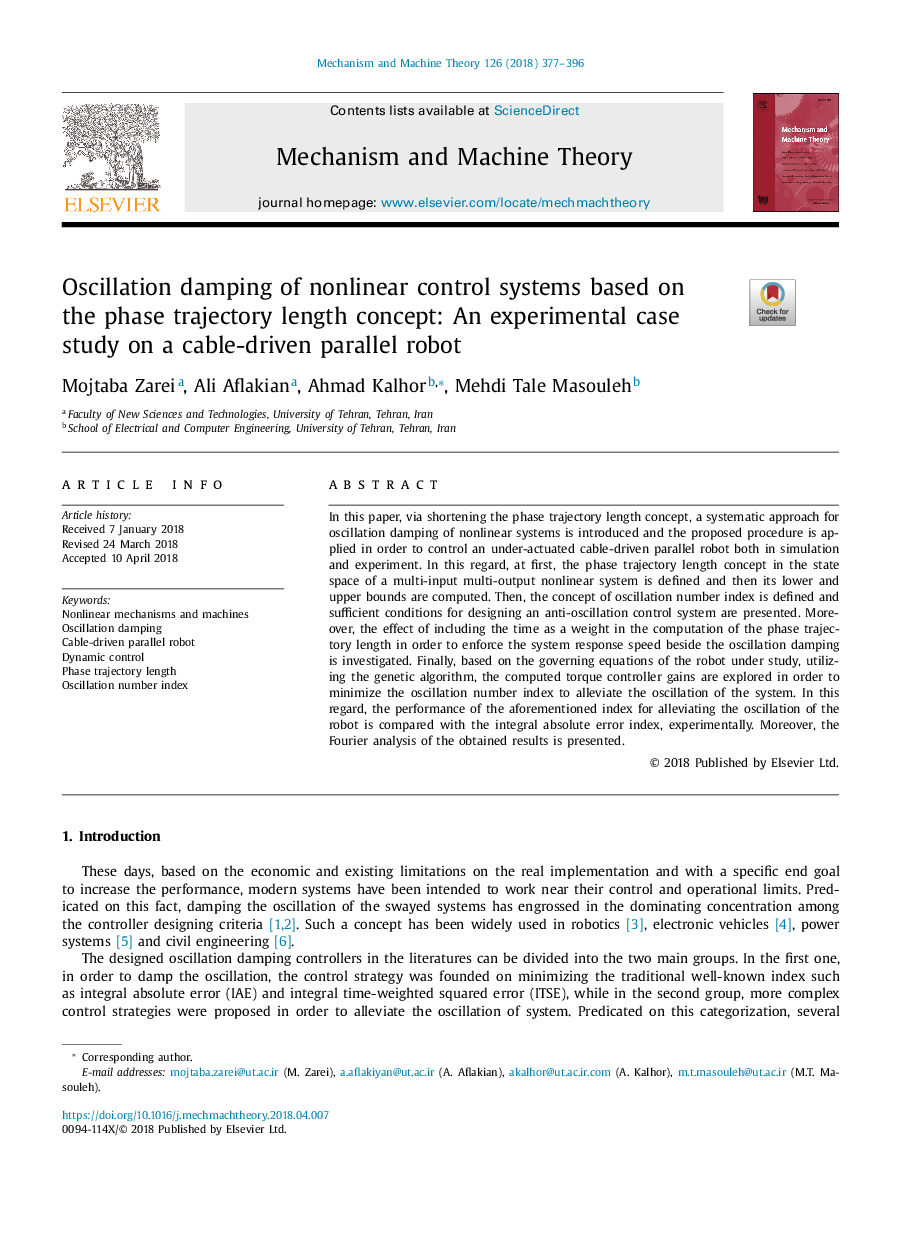| کد مقاله | کد نشریه | سال انتشار | مقاله انگلیسی | نسخه تمام متن |
|---|---|---|---|---|
| 7179090 | 1467709 | 2018 | 20 صفحه PDF | دانلود رایگان |
عنوان انگلیسی مقاله ISI
Oscillation damping of nonlinear control systems based on the phase trajectory length concept: An experimental case study on a cable-driven parallel robot
ترجمه فارسی عنوان
محاسبه نوسانات سیستم های کنترل غیرخطی بر مبنای مفهوم طول مسیر فاز: یک مطالعه موردی آزمایشی بر روی یک روبات موازی با راننده کابل
دانلود مقاله + سفارش ترجمه
دانلود مقاله ISI انگلیسی
رایگان برای ایرانیان
کلمات کلیدی
مکانیسم های غیر خطی و ماشین آلات، نوسان نوسان روبات موازی با راننده کابل، کنترل پویا، طول مسیر فاز، شاخص عدد نوسان،
ترجمه چکیده
در این مقاله، از طریق کوتاه سازی مفهوم طول مسیر فاز، یک روش سیستماتیک برای کاهش نوسانات سیستم های غیر خطی معرفی شده است و روش پیشنهادی برای کنترل یک روبات موازی با کنترل از راه دور که در شبیه سازی و آزمایش انجام می شود، مورد استفاده قرار می گیرد. در این راستا، ابتدا مفهوم طول مسیر فاز در فضای حالت یک سیستم غیرخطی چند خروجی چند ورودی تعریف شده و سپس محدوده پایین و مرز آن محاسبه می شود. سپس مفهوم عدد نوسان شکل تعریف شده و شرایط کافی برای طراحی سیستم کنترل ضد نوسان ارائه شده است. علاوه بر این اثر زمان شامل وزن در محاسبه طول مسیر فاز برای اجرای سرعت پاسخ سیستم در کنار نوسان نوسان مورد بررسی قرار گرفته است. در نهایت، بر اساس معادلات حاکم بر ربات مورد مطالعه، با استفاده از الگوریتم ژنتیک، دستاوردهای کنترل کننده گشتاور محاسبه شده برای به حداقل رساندن شاخص عدد نوسان برای کاهش نوسانات سیستم مورد بررسی قرار می گیرد. در این راستا، عملکرد این شاخص برای کاهش ریسک ربات به طور تجربی با شاخص خطای مطلق انتگرال مقایسه شده است. علاوه بر این، تجزیه و تحلیل فوریه نتایج به دست آمده ارائه شده است.
موضوعات مرتبط
مهندسی و علوم پایه
سایر رشته های مهندسی
مهندسی صنعتی و تولید
چکیده انگلیسی
In this paper, via shortening the phase trajectory length concept, a systematic approach for oscillation damping of nonlinear systems is introduced and the proposed procedure is applied in order to control an under-actuated cable-driven parallel robot both in simulation and experiment. In this regard, at first, the phase trajectory length concept in the state space of a multi-input multi-output nonlinear system is defined and then its lower and upper bounds are computed. Then, the concept of oscillation number index is defined and sufficient conditions for designing an anti-oscillation control system are presented. Moreover, the effect of including the time as a weight in the computation of the phase trajectory length in order to enforce the system response speed beside the oscillation damping is investigated. Finally, based on the governing equations of the robot under study, utilizing the genetic algorithm, the computed torque controller gains are explored in order to minimize the oscillation number index to alleviate the oscillation of the system. In this regard, the performance of the aforementioned index for alleviating the oscillation of the robot is compared with the integral absolute error index, experimentally. Moreover, the Fourier analysis of the obtained results is presented.
ناشر
Database: Elsevier - ScienceDirect (ساینس دایرکت)
Journal: Mechanism and Machine Theory - Volume 126, August 2018, Pages 377-396
Journal: Mechanism and Machine Theory - Volume 126, August 2018, Pages 377-396
نویسندگان
Mojtaba Zarei, Ali Aflakian, Ahmad Kalhor, Mehdi Tale Masouleh,
